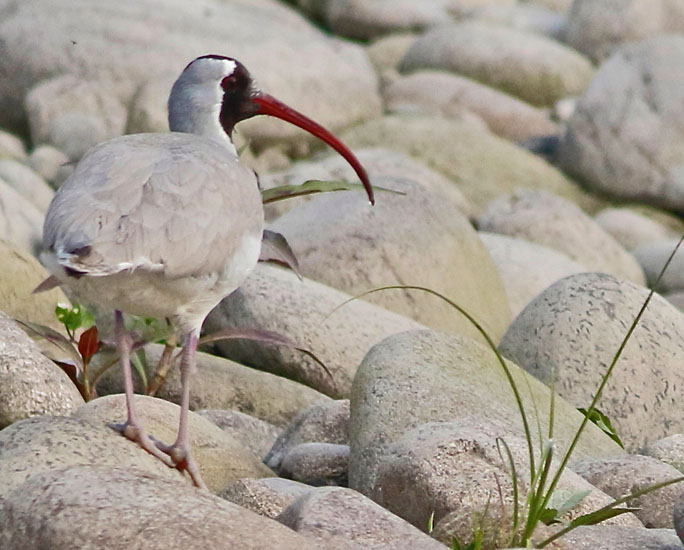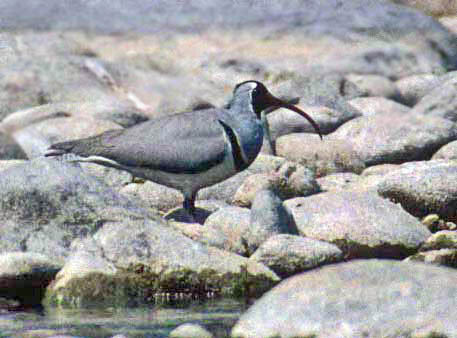
a web page by Don Roberson |
IBISBILL Ibidorhynchidae |
|
Ibisbill (left) wears the same dapper plumage throughout the year. Freshly molted birds have white-tipped feathers in the black face but these wear off as the breeding season approaches. This March bird was essentially black-faced. |
 |
Although the Ibisbill has a reasonably large range in central Asia, numbers are small and birds occur only locally as it is very specialized in its requirements. Food consists of aquatic invertebrates and the occasional small fish; it forages by probing among stones and boulders in the riverbed, sometimes wading deeply, but also by raking its bill through gravelly margins (Knystautas 1996). In the photo (above) an Ibisbill shares its habitat with a migrant Common Sandpiper Actitis hypoleucos in Bhutan. This is the Ibisbill's preferred habitat: non-vegetated rocky shores along a wide stony-bedded river. Unlike other river specialists of this zone (such as Brown Dipper Cinclus pallasii or White-capped Redstart Chaimarrornis leucocephalus) which are adapted to both swiftly-flowing streams and more sluggish rivers, the Ibisbill requires stretches of slow-moving water for its deliberate probing. Sibley & Monroe (1980) considered it just a very odd avocet (within their tribe Recurvirostrini based mostly on DNA evidence), taxonomists now routinely elevate it to its own monotypic family. Hayman et al. (1986) noted that it is "unique in both appearance and habits but may be distantly related both to oystercatchers and to stilts and avocets." Its young and its territorial behavior are similar to oystercatchers. Knystautas (1996), summarizing evidence and arguments both pro and con on its elevation to family status, concluded that "there is probably sufficient reason to justify classifying the Ibisbill in a family of its own, perhaps forming some sort of link between Haematopodidae [Oystercatchers] and Recurvirostridae [Avocets & Stilts]." More recent genetic and structural studies support the concept that it is mostly closely related to oystercatchers, with a bit more distant relationship to the Recurvirostridae (Baker et al. 2007, Mayr 2011). |
Years later I returned to Assam, northeastern India, on a tour. One -mid-March day we floated on large rafts down the wide, fast-flowing Jia Bharali (Kameng River). We saw 3 Ibisbill (on shown below) along 13 km of rocky shores over the two-hour ride. This, too, is a wintering area and we were fortunate that a few birds still remained. I was again amazed at how difficult it was to spot an Ibisbill at any distance — its plumage camouflage is very impressive. |
 |
Photos: The first and last shots of Ibisbill Ibidorhyncha struthersii were along the Jia Bharali (Kameng River), Assam, India, on 14 Mar 2019. The distant photo of a Common Sandpiper and an Ibisbill was at Jakar, Bhutan, on 25 Mar 2019. My first photo of Ibisbill, digitized from a slide, was along the Kosi River, Ramnagar, Uttarakhand, India, on 13 Mar 2001. All photos © Don Roberson; all rights reserved. Bibliographic note: There is no "family book" focused on this monotypic family, but a fine introduction to this family, with some excellent photos, is in Knystautas (1996). More generally, Ibisbill is covered among multiple wader families in Hayman et al. (1986). Literature cited:
|
 Ibisbill is a strange and unique wader of wide high-altitude Himalayan and Tibetan Plateau valleys with flat stony rivers. Its range extends across central Asia from Kazakhstan to China and south to north India. Ibisbill is often considered among the "most-wanted" birds in the world; it is often considered the "bird of the trip" by those fortunate enough to visit higher elevations in central Asia. Now that both China and Bhutan are open to world birders, seeing Ibisbill is not as difficult as in the past, but it is so unique and distinctive, and yet so camouflaged among rocky river shores, that it remains a major trip highlight.
Ibisbill is a strange and unique wader of wide high-altitude Himalayan and Tibetan Plateau valleys with flat stony rivers. Its range extends across central Asia from Kazakhstan to China and south to north India. Ibisbill is often considered among the "most-wanted" birds in the world; it is often considered the "bird of the trip" by those fortunate enough to visit higher elevations in central Asia. Now that both China and Bhutan are open to world birders, seeing Ibisbill is not as difficult as in the past, but it is so unique and distinctive, and yet so camouflaged among rocky river shores, that it remains a major trip highlight. Ibisbills breed at quite high elevation which adds to their allure. They nest on riverine shingle-banks and islets between 1700-4400m (5,500-14,000' elev.) during late March-early June. While primarily resident (e.g., Spierenburg 2005), some Himalayan birds descend to lower elevations in winter. There are locales in both northwestern and northeastern India where they can be sought in winter. I had been worried that our March 2001 trip to northwestern India would be too late in the season but to maximize our chances. We headed for the Kosi River at Ramnagar, near Corbett NP, first. There a rocky river winds through a wide valley at perhaps 400m (1300' elev.) — a winter habitat looking very much like that which the Ibisbill prefers in summer. Later we learned from local guide Karan Pradhan that there had been 17 Ibisbills that winter along a ten-mile stretch of the Kosi River above Ramnagar. We felt very fortunate to locate a single Ibisbill on 12 & 13 March (right).
Ibisbills breed at quite high elevation which adds to their allure. They nest on riverine shingle-banks and islets between 1700-4400m (5,500-14,000' elev.) during late March-early June. While primarily resident (e.g., Spierenburg 2005), some Himalayan birds descend to lower elevations in winter. There are locales in both northwestern and northeastern India where they can be sought in winter. I had been worried that our March 2001 trip to northwestern India would be too late in the season but to maximize our chances. We headed for the Kosi River at Ramnagar, near Corbett NP, first. There a rocky river winds through a wide valley at perhaps 400m (1300' elev.) — a winter habitat looking very much like that which the Ibisbill prefers in summer. Later we learned from local guide Karan Pradhan that there had been 17 Ibisbills that winter along a ten-mile stretch of the Kosi River above Ramnagar. We felt very fortunate to locate a single Ibisbill on 12 & 13 March (right).